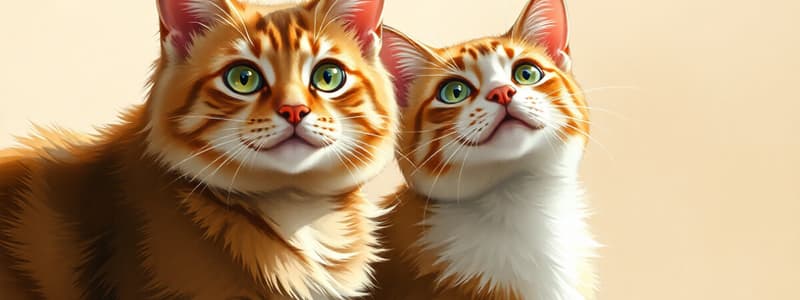Podcast
Questions and Answers
What is the average lifespan of domestic cats?
What is the average lifespan of domestic cats?
- 15-20 years
- 10-12 years
- 12-15 years (correct)
- 5-10 years
Which of the following traits are common among cats?
Which of the following traits are common among cats?
- Retractable claws (correct)
- Strong pack behavior
- Diurnal hunting patterns
- Vocalization dependency
What is the primary dietary requirement of domestic cats?
What is the primary dietary requirement of domestic cats?
- Grains and vegetables
- Dairy products
- Animal protein (correct)
- Carbohydrates
What are some common health issues that domestic cats face?
What are some common health issues that domestic cats face?
How do cats typically communicate their feelings?
How do cats typically communicate their feelings?
Flashcards are hidden until you start studying
Study Notes
General Facts
- Domestic cats (Felis catus) belong to the family Felidae.
- Estimated to have been domesticated around 9,000 years ago.
- Cats are one of the most popular pets worldwide.
Physical Characteristics
- Average weight: 5-20 pounds.
- Average lifespan: 12-15 years, with some living into their 20s.
- Distinctive features: retractable claws, sharp teeth, keen eyesight, and acute hearing.
Behavior
- Cats are solitary hunters; they rely on stealth and patience.
- Communication: meowing, purring, hissing, and body language (tail position, ear orientation).
- Social structure: Generally more independent than dogs but can form strong bonds with humans and other animals.
Breeds
- Recognized breeds: Siamese, Persian, Maine Coon, Bengal, Ragdoll, and many others.
- Breeds vary in size, color, fur length, and temperament.
Diet
- Obligate carnivores: require animal protein to thrive.
- Common dietary sources: commercial cat food, fresh meat, and occasional fish.
- Important nutrients: taurine, arachidonic acid, and vitamin A (not synthesized from plant sources).
Health and Care
- Regular veterinary check-ups (annual vaccinations, parasite control).
- Common health issues: obesity, dental disease, kidney disease, diabetes.
- Importance of spaying/neutering to prevent overpopulation and certain health issues.
Behavior Enrichment
- Providing toys, scratching posts, and climbing structures to stimulate mental and physical activity.
- Interactive play sessions to enhance bonding and exercise.
Unique Traits
- Grooming behavior: Cats spend a significant amount of time grooming to maintain cleanliness and regulate body temperature.
- Territorial: Cats often have specific territories they roam and may exhibit behaviors to defend them.
Myths and Misconceptions
- Cats are not aloof; they can be affectionate and social creatures.
- They don’t always land on their feet; while they do have a righting reflex, not every fall ensures a safe landing.
Popular Culture
- Cats appear frequently in literature, movies, and internet memes (e.g., Grumpy Cat, Nyan Cat).
- Symbolically represented as creatures of mystery, independence, and occasionally bad luck (e.g., black cats).
Domestic Cats
- Family: Felidae
- Domestication: Estimated to be around 9,000 years ago
- Popularity: One of the most popular pets worldwide.
Physical Characteristics
- Weight: Average weight of 5-20 pounds.
- Lifespan: Average lifespan of 12-15 years, with some living into their 20s.
- Distinctive Features: Retractable claws, sharp teeth, keen eyesight, and acute hearing.
Behavior
- Solitary Hunters: Rely on stealth and patience.
- Communication: Meowing, purring, hissing, and body language: tail position, ear orientation.
- Social Structure: Generally more independent than dogs but can form strong bonds.
Breeds
- Recognized Breeds: Siamese, Persian, Maine Coon, Bengal, Ragdoll, and many others.
- Breed Differences: Variation in size, color, fur length, and temperament.
Diet
- Obligate Carnivores: Need animal protein to thrive.
- Common Dietary Sources: Commercial cat food, fresh meat, and occasional fish.
- Essential Nutrients: Taurine, arachidonic acid, and vitamin A.
Health and Care
- Veterinary Check-ups: Annual vaccinations and parasite control.
- Common Health Issues: Obesity, dental disease, kidney disease, and diabetes.
- Spaying/Neutering: Important to prevent overpopulation and certain health issues.
Behavior Enrichment
- Stimulation: Toys, scratching posts, and climbing structures to stimulate mental and physical activity.
- Bonding and Exercise: Interactive play sessions.
Unique Traits
- Grooming: Cats spend considerable time grooming to maintain cleanliness and regulate body temperature.
- Territoriality: Cats often have territories they roam and may exhibit behaviors to defend them.
Myths and Misconceptions
- Affectionate and Social: Contrary to popular belief, cats can be affectionate and social.
- Landing on Feet: While they have a righting reflex, it doesn't guarantee a safe landing in every fall.
Popular Culture
- Literature, Movies, and Memes: Cats appear frequently in literature, movies, and internet memes.
- Symbolism: Often represented as creatures of mystery, independence, and occasionally bad luck.
Studying That Suits You
Use AI to generate personalized quizzes and flashcards to suit your learning preferences.




